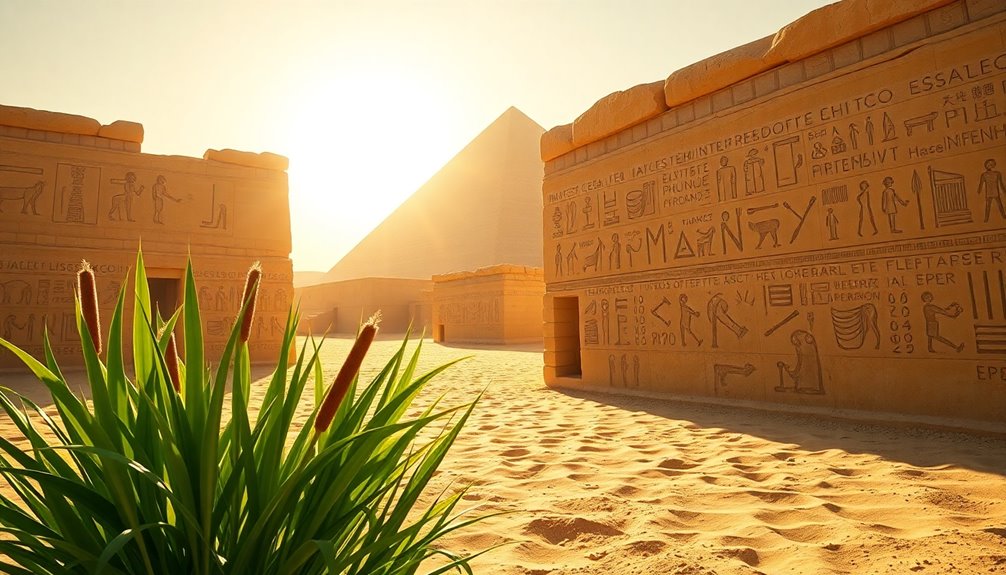Egyptian names are a mesmerizing window into the legacy of the pharaohs. Each name embodies a deep connection to divine power, authority, and cultural identity. You'll find key titles like the Horus name and the Prenomen, which signified a ruler's essence and responsibilities. Figures like Hatshepsut and Ramses II showcase this rich heritage, inspiring awe with their powerful titles. Modern research continues to unravel these timeless names, influencing art and culture today. If you're curious about how these names shaped ancient society and their impact, there's much more to explore in this mesmerizing history.
Key Takeaways
- Egyptian names, such as Khufu and Hatshepsut, reflect the divine authority and cultural significance of pharaohs in ancient Egypt.
- The royal titulary includes key components like the Horus name and Prenomen, emphasizing the ruler's sacred duty.
- Names like "Sa Re" and "Tutankhamun" connect pharaohs to deities, enhancing their legitimacy and power in society.
- Archaeological findings, including the Rosetta Stone, have deepened our understanding of the meanings behind these timeless titles.
- Egyptian mythology continues to influence modern culture, inspiring names in branding, art, and literature today.
Definition of Royal Titulary
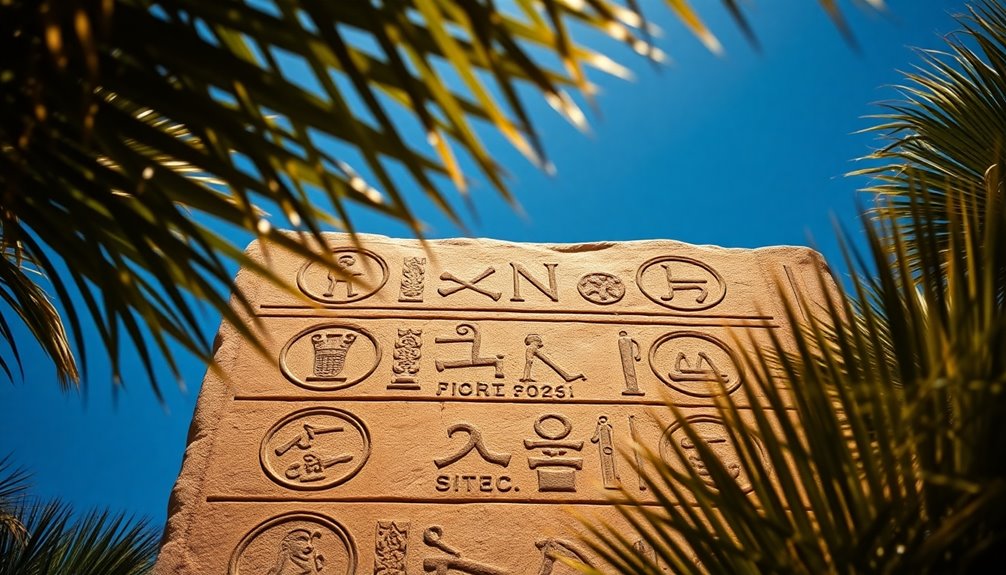
The royal titulary is a crucial aspect of ancient Egyptian rulers' identity, consisting of formal titles that legitimize their authority and divine right to rule. This titulary includes several key components, such as the Horus name, which symbolizes the ruler's divine connection and role as protector of Egypt.
The Nomen and Prenomen represent the individual's personal name and their royal name, respectively, showcasing their lineage and legitimacy. As you explore the royal titulary, you'll notice how it evolved over time, particularly during the Middle and New Kingdoms.
The increasing complexity of these titles reflects the shifts in political power and ideology within ancient Egyptian society. Each title served a specific purpose, emphasizing the interconnectedness of religion, politics, and culture.
Inscriptions of the royal titulary adorned monuments, tombs, and official documents, often accompanied by symbolic imagery in art and hieroglyphs. These inscriptions weren't just decorative; they reinforced the rulers' divine right and established their place in the pantheon of ancient Egyptian history.
Understanding the royal titulary gives you a deeper insight into the significance of names and titles in the context of ancient Egyptian leadership.
Key Components of Egyptian Names
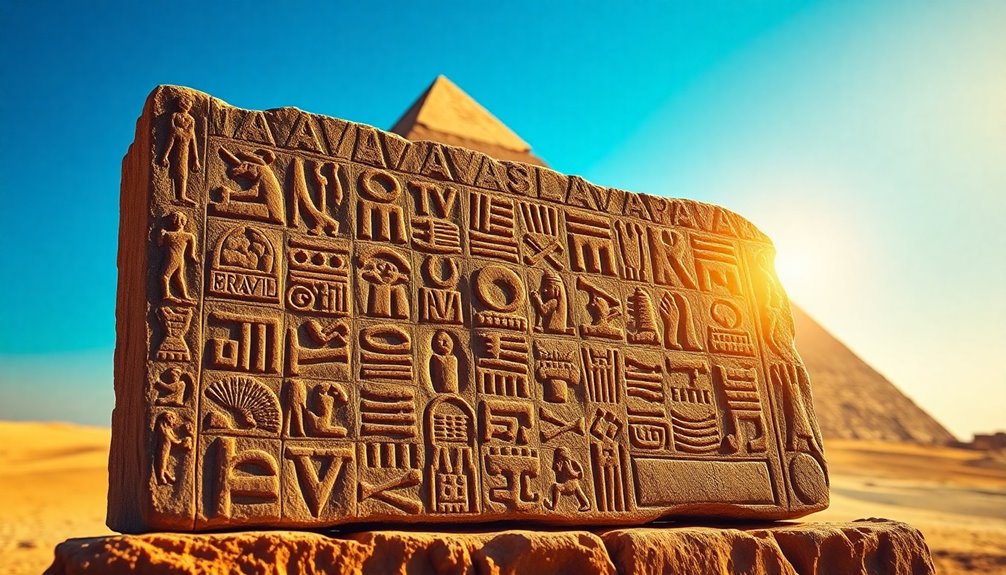
When you explore Egyptian names, you'll notice a clear hierarchical title structure that signifies power and status.
Many names include divine associations, connecting rulers to gods like Ra and Amun, which reinforces their authority.
Over time, royal titles evolved, reflecting changes in society and the importance of identity in both the mortal domain and the afterlife.
Hierarchical Title Structure
In ancient Egypt, names weren't just labels; they held profound significance tied to the king's divine authority and role in society. The hierarchical title structure of Egyptian names consists of five primary titles that illustrate the king's connection to divinity and governance.
The Horus name symbolizes the king's relationship with the falcon god Horus, often depicted in a serekh, asserting royal supremacy.
Next, the Nebty name signifies the unification of Upper and Lower Egypt, represented by the vulture and cobra hieroglyphs, reflecting the political and religious importance of goddesses Nekhbet and Wadjet.
The Golden Horus name showcases the king's triumph over enemies and embodies concepts of eternity and divine kingship, frequently featuring the Horus falcon alongside gold hieroglyphs.
Lastly, the Prenomen, or Neswbity name, translates to "he who belongs to the sedge and the bee." This title emphasizes the king's authority over both regions of Egypt and is traditionally inscribed within a cartouche, symbolizing eternity.
Together, these titles not only identify the king but also convey his sacred duty and the unity of his domain.
Divine Associations in Names
Divine associations in Egyptian names reveal a deep cultural belief in the gods' influence over human existence. Many names, like "Sa Re," meaning "Son of Ra," underscore a direct connection to the sun god, reinforcing the importance of divine lineage.
You'll notice that names such as "Hatshepsut," meaning "foremost of noble women," highlight royal status and the significance of female rulers, emphasizing their divine favor and connections.
Names like "Nefertari," which means "beautiful companion," also suggest that personal attributes are tied to the blessings of the gods. This reflects how individuals believed their traits could be influenced by divine associations.
Moreover, names like "Anubis," meaning "royal child," link people to specific deities, showcasing their protective roles in life and the afterlife.
Additionally, Egyptian names often illustrate powerful affiliations with gods and nature. For instance, "Khepri," meaning "he who comes into being," symbolizes rebirth and the eternal cycle of life, emphasizing the integral relationship between humans and the divine in ancient Egypt.
These associations not only shaped identities but also reinforced a sense of connection to the divine domain.
Evolution of Royal Titles
The evolution of royal titles in ancient Egypt reflects a complex interplay of power, identity, and divine connection. The royal titulary comprised five primary titles, each highlighting different aspects of the king's authority and divine nature. Understanding these titles gives you insight into how ancient Egyptians viewed their rulers.
Here's a breakdown of these key titles:
| Title | Description |
|---|---|
| Horus name | Embodies divine power, depicted in a serekh with Horus. |
| Nebty name | Represents the unification of Upper and Lower Egypt. |
| Golden Horus name | Signifies triumph over chaos, associated with eternity. |
| Prenomen | The principal royal name, reflecting identity and lineage. |
The Horus name symbolizes the king's royal supremacy, while the Nebty name emphasizes unity among the lands. The Golden Horus name further enhances the king's divine connection, illustrating strength and eternity. Finally, the Prenomen, written in cartouches, emerged as the kings' name of choice by the late Old Kingdom. These titles collectively reflect the profound significance of identity and power in ancient Egyptian culture.
Historical Evolution of Titles
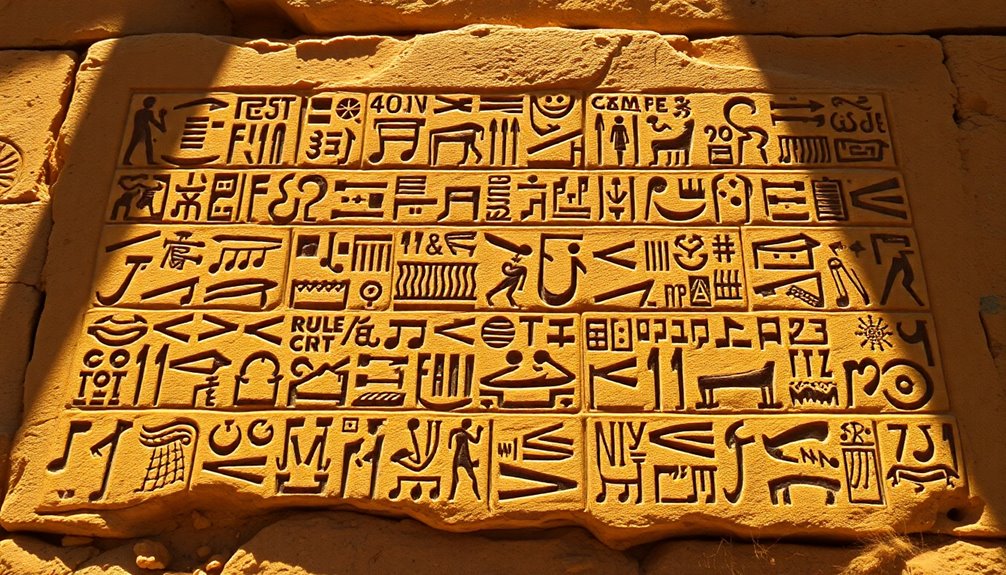
Evolving over centuries, royal titles in ancient Egypt reflect the changing nature of power and identity. In the early dynastic period, titles were simple, but as time passed, they became more complex, particularly during the Middle and New Kingdoms.
The title nsw bi.tj, introduced by King Den of the 1st Dynasty, marked a significant shift in the royal titulary system by the end of the 3rd Dynasty.
During the late Old Kingdom, the prenomen emerged as the principal royal name, often enclosed in a cartouche to signify eternity. This was a notable change in the historical evolution of titles.
The 4th Dynasty saw the incorporation of Re into royal titles, emphasizing divine kingship and the monarch's connection to the sun god.
Cultural Significance of Names
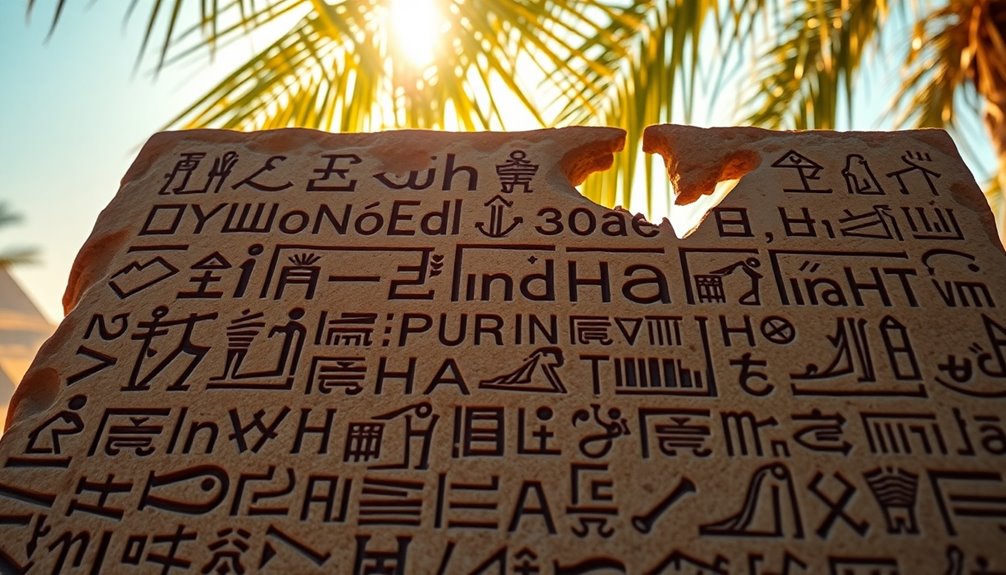
Names in ancient Egypt carried profound cultural significance, often intertwining with the spiritual and political fabric of society. Many names reflected divine connections, with pharaohs incorporating the names of gods like Amun and Ra to assert their authority and divine right to rule. This practice underscores the political significance of names, as they not only identified individuals but also reinforced their power and unity over Upper and Lower Egypt.
The meanings behind names, such as "Nefertari" (beautiful companion) and "Akhenaten" (effective for Aten), reveal aspirations linked to beauty, power, and spirituality, illustrating the cultural significance placed on identity. Women, too, bore names that emphasized their strength and influence, showcasing their essential roles in governance and society.
Additionally, celestial references in names, like "Khepri" (he who comes into being) and "Nut" (goddess of the sky), highlight the ancient Egyptians' reverence for the natural world. By intertwining names with elements of nature and the divine, ancient Egyptians created a rich tapestry of identity that spoke to their enduring values and beliefs.
Your understanding of these names deepens your appreciation of their cultural legacy.
Prominent Pharaohs and Their Titles
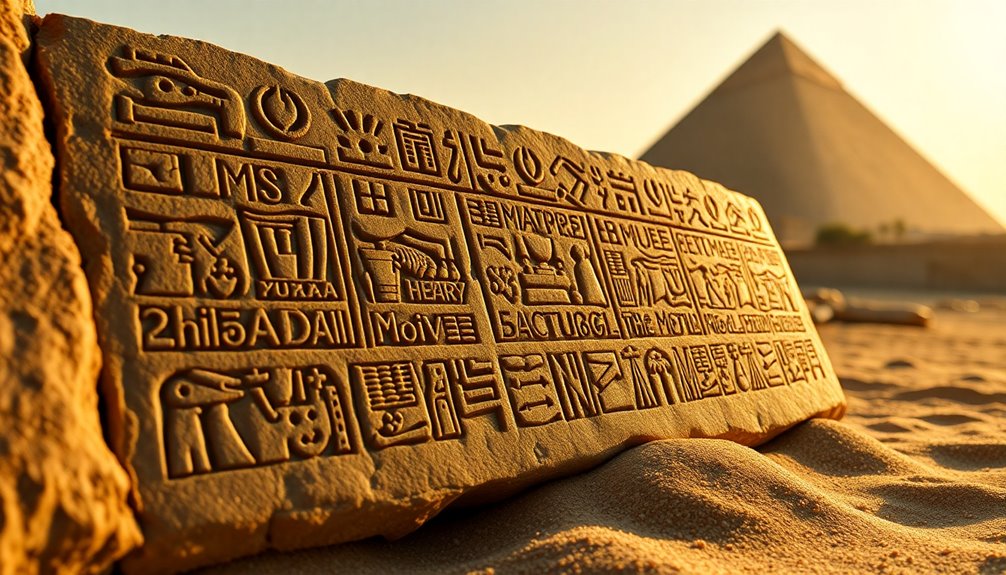
Throughout ancient Egypt, prominent pharaohs stood out for their remarkable achievements and the titles they held, which often reflected their divine connections and political power.
One of the most famous, Khufu, is celebrated for constructing the Great Pyramid of Giza. His title, meaning "protected by Khnum," emphasizes the divine protection that underpinned his monumental accomplishment.
Hatshepsut, the only female pharaoh to rule in her own right, was honored as "foremost of noble women," showcasing her significant contributions to leadership and trade.
Another legendary figure, Ramses II, known as Ramses the Great, held an extensive titulary that included various military and religious titles, highlighting his remarkable reign and achievements.
Tutankhamun, the young pharaoh, bore the title meaning "living image of Amun," showcasing the importance of divine lineage in ancient Egypt.
Finally, Amenhotep IV, who later became Akhenaten, introduced radical religious reforms and held the title meaning "effective for Aten," marking a significant shift in worship practices.
These titles not only defined their reigns but also served as lasting legacies of their divine connections and leadership in ancient Egypt.
The Role of Divine Connection
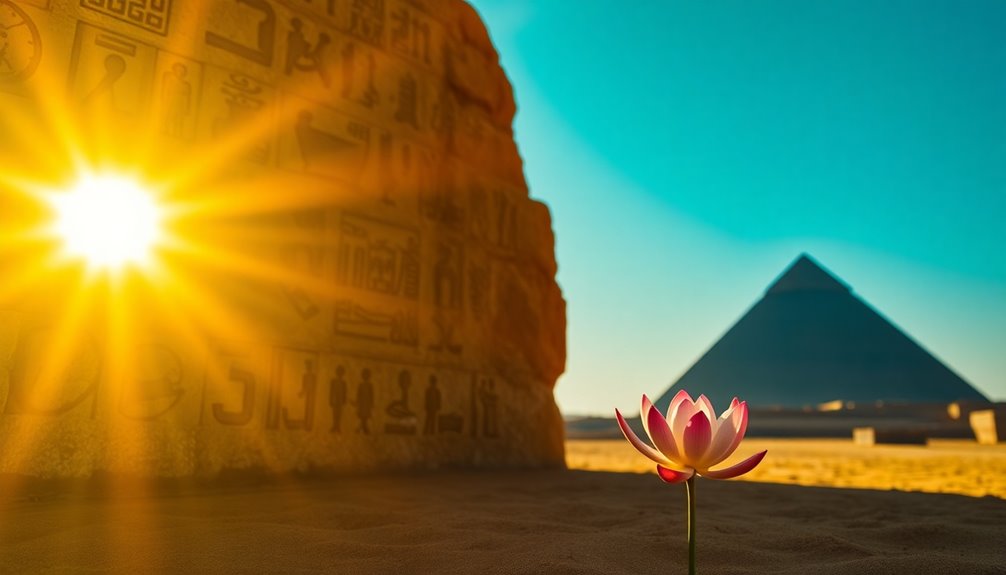
Pharaohs in ancient Egypt often reinforced their authority and legitimacy through their divine connections, intertwining their identities with the gods. By embedding divine elements in their titles, they projected their divine authority, assuring the people of their rightful rule. The sacred lineage was vital, as seen with the Sa Re name, meaning "son of Re," which emphasized a direct link to the sun god, strengthening their position.
Names like Khufu, meaning "protected by Khnum," highlight how rulers sought divine favor. The royal titulary included significant titles like the Golden Horus name, symbolizing strength and victory over chaos, enhancing their divine image.
Here's a table illustrating different pharaoh's titles and their meanings:
| Pharaoh's Name | Meaning |
|---|---|
| Khufu | Protected by Khnum |
| Hatshepsut | Foremost of noble women |
| Sa Re | Son of Re |
| Golden Horus | Symbol of strength and victory |
These titles not only defined their identities but also connected them to the spiritual domain, ensuring their place as divine rulers in the eyes of their subjects.
Modern Research on Egyptian Names

When you explore modern research on Egyptian names, you'll find that archaeological discoveries greatly shape our understanding of naming conventions.
Researchers analyze how titles and names evolved over time, reflecting changes in society and culture.
Archaeological Discoveries Impacting Names
Archaeology has transformed our understanding of ancient Egyptian names, revealing their profound connections to power and divinity. Recent archaeological discoveries, particularly inscriptions found on temple walls and in tombs, have shed light on the meanings and origins of royal names. These findings highlight how names often reflected divine attributes, reinforcing the authority of pharaohs.
The Rosetta Stone was pivotal in deciphering hieroglyphs, allowing you to grasp the phonetics and meanings behind many previously mysterious names. This breakthrough has opened doors to understanding how certain names were instrumental in conveying political dynamics and authority in ancient Egypt.
Excavations of royal burial sites have uncovered artifacts that indicate the significance of particular names, emphasizing their role in asserting power. Studies of dynastic lineage, supported by these archaeological findings, clarify the relationships between pharaohs and their chosen names, showcasing the importance of divine connections.
Moreover, modern research utilizing advanced imaging techniques has enabled scholars to analyze faded inscriptions, revealing lost names and titles. This ongoing work enhances our understanding of the cultural legacy of ancient Egypt, making the study of these names even more fascinating.
Linguistic Evolution of Titles
The evolution of royal titles in ancient Egypt offers a fascinating glimpse into the shifting dynamics of power and culture over the centuries. Modern research uncovers how these royal titles changed in meaning, reflecting varying political power and cultural significance across dynasties. For instance, the term "Pharaoh," originating from "pr-aA" (Great House), initially referred to the palace. By the end of the 12th Dynasty, it became a respectful title for the king.
Linguistic studies reveal that the prenomen, often presented in a cartouche, symbolized eternity and highlighted the divine nature of kingship. This representation underscored the belief that the Pharaoh wasn't just a political leader but also a divine figure.
The introduction of titles like "sA Ra" (son of Ra) during the early 4th Dynasty marked a pivotal shift towards emphasizing divine lineage, showcasing the king's connection to the sun god.
Recent analyses of titulary inscriptions provide insights into dynastic relationships and the intertwining of religion and politics in ancient Egyptian society. This evolution speaks to the profound influence of societal values on royal identity and authority throughout history.
Influence on Contemporary Culture
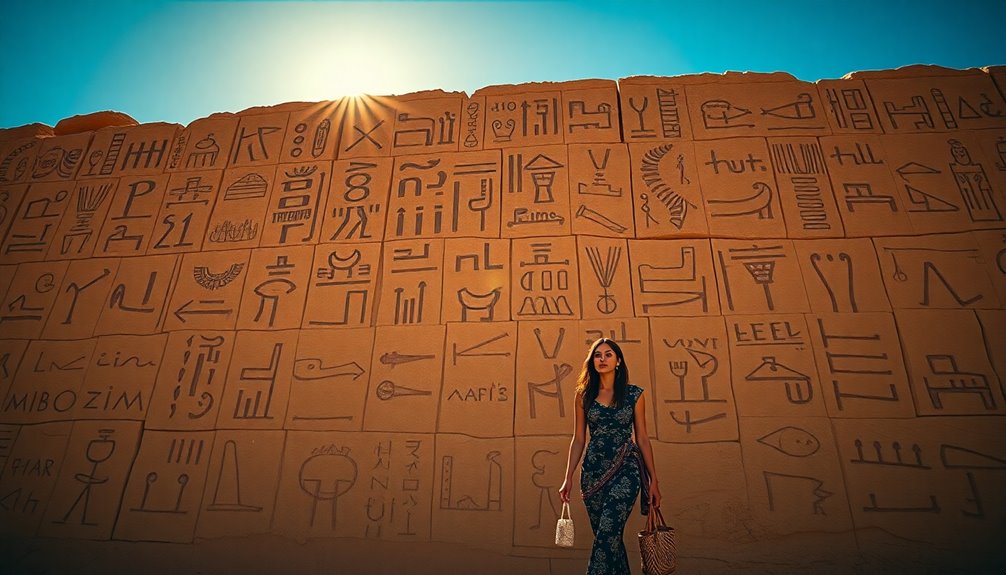
How have ancient Egyptian names shaped our contemporary culture? You'll find that names like "Cleopatra" and "Tutankhamun" resonate deeply, reflecting the enduring influence of these iconic figures. The symbolism tied to deities such as "Ra" and "Horus" inspires modern naming conventions, often evoking themes of strength and divinity in brands and products.
Moreover, themes from Egyptian mythology, particularly those related to "Isis" and "Osiris," have made their way into literature, film, and art, creating narratives infused with the mystique of ancient Egypt. This fascination has also fueled a resurgence in Egyptology, impacting modern fashion, jewelry, and architecture, which frequently incorporate pharaonic motifs.
You might notice the aesthetic appeal of hieroglyphs in contemporary design, seen in tattoos and graphic art. This trend highlights a growing appreciation for the meanings embedded in ancient Egyptian names, allowing you to connect with a culture that continues to captivate.
The Legacy of Egyptian Titulary
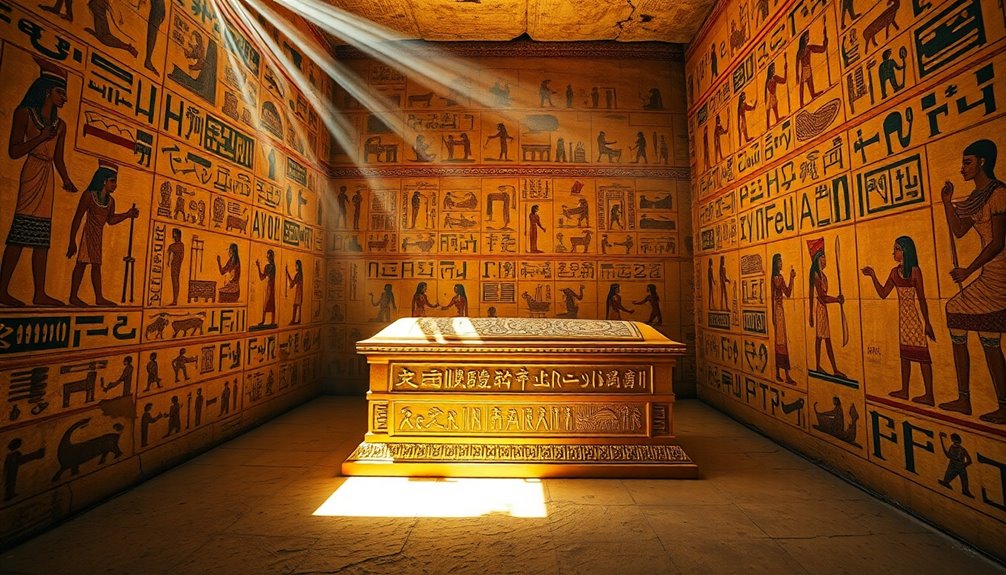
Delving into the legacy of Egyptian titulary reveals a fascinating system of names and titles that defined the identity and divine authority of pharaohs. The royal titulary of ancient Egyptian rulers included five primary titles: the Horus name, Nebty name, Golden Horus name, Nomen, and Prenomen. Each title played a vital role in symbolizing the king's power and divine connection.
The Horus name, often depicted within a serekh, connects the king to the falcon god Horus, representing protection and kingship. In contrast, the Nebty name illustrates the unification of Upper and Lower Egypt, showcasing the vulture and cobra as powerful symbols of this union.
The Golden Horus name, emerging in Dynasty XI, emphasizes the king's strength and triumph over Set, reinforcing the divine nature of kingship. The Nomen, or throne name, framed in a cartouche, reflects the king's lineage, while the Prenomen signifies the birth name and often includes divine epithets.
The evolution of this royal titulary mirrors shifts in political power and ideology, with rulers like Ramses II and Tutankhamun exemplifying the titles' complexity and significance in ancient Egyptian governance.
Frequently Asked Questions
What Were the Titles of the Egyptian Pharaohs?
The titles of Egyptian pharaohs reflect their divine and earthly authority.
You'll find five primary titles: the Horus name, which connects the king to divine kingship; the Nebty name, symbolizing the unification of Upper and Lower Egypt; the Golden Horus name, highlighting strength and victory; the Prenomen, or birth name, which signifies the king's identity; and the Nomen, or throne name, representing his lineage and role.
Each title carries significant meaning.
What Are the Five Royal Titles in Ancient Egypt?
In ancient Egypt, you'd encounter five primary royal titles representing the pharaoh's authority.
The Horus Name connects the king to the falcon god, while the Nebty Name symbolizes the unification of Upper and Lower Egypt.
The Golden Horus Name showcases victory over enemies.
Additionally, the Nomen indicates the king's lineage, and the Prenomen, or birth name, highlights his role as "King of Upper and Lower Egypt."
Each title reflects different aspects of divine kingship.
What Are the Oldest Egyptian Names?
Imagine standing before the Great Pyramid of Giza, knowing it was built under the reign of Khufu, one of the oldest Egyptian names.
The earliest names, like Narmer and Horus Den, emerged during the Early Dynastic Period, symbolizing divine kingship.
These names weren't just for identification; they reflected the rulers' power and connection to deities like Amun and Ra, intertwining religion and politics in ancient Egyptian life.
What Were the Ranks of Egyptian Royalty?
In ancient Egypt, you'd find a structured hierarchy among royalty. At the top, the Pharaoh reigned as a divine ruler. Below him, queens, princes, and princesses held important roles.
High-ranking officials, like viziers and generals, managed state affairs and advised the Pharaoh. Nobles and elite landowners wielded local power, while commoners and artisans supported the economy.
Each rank played a vital role in maintaining the kingdom's stability and prosperity.
Conclusion
In exploring Egyptian names, you uncover a rich tapestry woven with both power and spirituality. The grandeur of royal titulary stands in stark contrast to the everyday names of the common people, yet both carry profound significance. Just as pharaohs claimed divine connections, ordinary individuals found strength in their identities. This duality reminds you that every name, whether regal or humble, tells a story that transcends time, connecting you to the enduring legacy of the land of the pharaohs.
